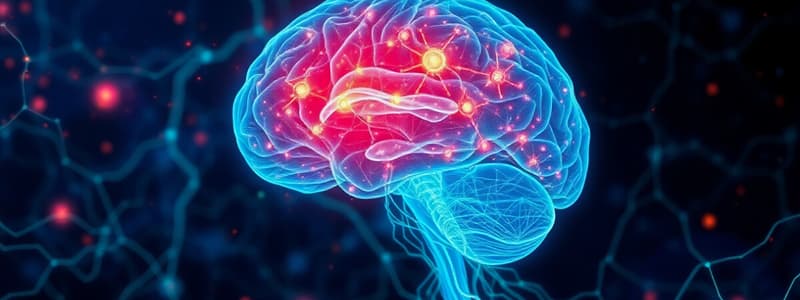Podcast
Questions and Answers
What role do pro-inflammatory cytokines play in the epileptic brain?
What role do pro-inflammatory cytokines play in the epileptic brain?
- They inhibit the activation of glia and neurons.
- They facilitate the formation of new synapses.
- They enhance neurotransmitter release.
- They lead to blood-brain barrier leakage. (correct)
Which signaling pathway is primarily activated in response to inflammatory triggers in the epileptic brain?
Which signaling pathway is primarily activated in response to inflammatory triggers in the epileptic brain?
- Wnt/β-catenin signaling pathway.
- IL-1 receptor/toll-like receptor signaling pathway. (correct)
- Notch signaling pathway.
- MAPK/ERK signaling pathway.
What is a potential consequence of peripheral inflammation in the context of epilepsy?
What is a potential consequence of peripheral inflammation in the context of epilepsy?
- Inhibition of leukocyte migration.
- Enhanced excitability of cortical neurons. (correct)
- Decreased glutamate levels in the CNS.
- Formation of new vascular pathways.
What initiates the inflammatory cascade linked to seizure events?
What initiates the inflammatory cascade linked to seizure events?
Which molecules are most likely released by activated glia and endothelial cells in response to neuroinflammation?
Which molecules are most likely released by activated glia and endothelial cells in response to neuroinflammation?
What mechanism primarily distinguishes the balance of excitation and inhibition in seizures and epilepsy?
What mechanism primarily distinguishes the balance of excitation and inhibition in seizures and epilepsy?
Which of the following describes the structural etiology of epilepsy?
Which of the following describes the structural etiology of epilepsy?
Hippocampal sclerosis frequently involves a loss of which type of neurons?
Hippocampal sclerosis frequently involves a loss of which type of neurons?
What term describes the reorganization phenomena observed in the granule cell layer following hippocampal sclerosis?
What term describes the reorganization phenomena observed in the granule cell layer following hippocampal sclerosis?
Which of the following best represents acquired structural causes of epilepsy?
Which of the following best represents acquired structural causes of epilepsy?
What is a potential consequence of elevated granule cell neurogenesis post-epileptogenic insult?
What is a potential consequence of elevated granule cell neurogenesis post-epileptogenic insult?
What type of genetic changes are involved in structural etiologies of epilepsy?
What type of genetic changes are involved in structural etiologies of epilepsy?
Which subregions of the hippocampus primarily exhibit pathological changes in hippocampal sclerosis?
Which subregions of the hippocampus primarily exhibit pathological changes in hippocampal sclerosis?
What is a primary characteristic of genetic generalized epilepsy (GGE)?
What is a primary characteristic of genetic generalized epilepsy (GGE)?
Which gene is associated with autosomal dominant nocturnal frontal lobe epilepsy (ADNFLE)?
Which gene is associated with autosomal dominant nocturnal frontal lobe epilepsy (ADNFLE)?
What outcome is associated with the mutation in the CHRNA4 gene in ADNFLE patients?
What outcome is associated with the mutation in the CHRNA4 gene in ADNFLE patients?
Which type of epilepsy is often characterized by developmental delay and poor prognosis?
Which type of epilepsy is often characterized by developmental delay and poor prognosis?
Which gene is linked to benign familial neonatal seizures?
Which gene is linked to benign familial neonatal seizures?
What effect does the dysfunction of NaV1.1 channels have in patients with Dravet syndrome?
What effect does the dysfunction of NaV1.1 channels have in patients with Dravet syndrome?
Which of the following best describes reactive gliosis?
Which of the following best describes reactive gliosis?
Which deletion on chromosomes is associated with juvenile myoclonic epilepsy?
Which deletion on chromosomes is associated with juvenile myoclonic epilepsy?
Which of these syndromes does not typically involve autonomic seizures?
Which of these syndromes does not typically involve autonomic seizures?
What is the main consequence of downregulated aquaporin 4 channels in astrocytes?
What is the main consequence of downregulated aquaporin 4 channels in astrocytes?
How many genes were associated with epilepsy in the study referenced?
How many genes were associated with epilepsy in the study referenced?
What mutation is primarily linked to the familial mesial temporal lobe epilepsy (FMTLE)?
What mutation is primarily linked to the familial mesial temporal lobe epilepsy (FMTLE)?
What type of epilepsy is primarily characterized by auditory ictal manifestations?
What type of epilepsy is primarily characterized by auditory ictal manifestations?
What is the relationship between large recurrent deletions at chromosome 15 and autism?
What is the relationship between large recurrent deletions at chromosome 15 and autism?
Which characteristic is typical of mutations resulting in epileptic encephalopathies?
Which characteristic is typical of mutations resulting in epileptic encephalopathies?
What is the proposed underlying mechanism of the “channelopathy” hypothesis regarding epilepsy syndromes?
What is the proposed underlying mechanism of the “channelopathy” hypothesis regarding epilepsy syndromes?
Which specific mutation is exemplified as a Nav-based channelopathy and how does it affect channel activity?
Which specific mutation is exemplified as a Nav-based channelopathy and how does it affect channel activity?
What are common infectious agents that can lead to an infectious etiology of epilepsy?
What are common infectious agents that can lead to an infectious etiology of epilepsy?
What percentage range of survivors of CNS infections may experience unprovoked seizures in developed countries?
What percentage range of survivors of CNS infections may experience unprovoked seizures in developed countries?
Which condition is not classified as a metabolic disorder leading to seizures?
Which condition is not classified as a metabolic disorder leading to seizures?
What type of response might lead to persistent neuronal hyperexcitability in the brain?
What type of response might lead to persistent neuronal hyperexcitability in the brain?
In the context of immune etiology of epilepsy, which antibody is associated with disrupting synaptic functions?
In the context of immune etiology of epilepsy, which antibody is associated with disrupting synaptic functions?
What characterizes metabolic epilepsies compared to symptomatic seizures?
What characterizes metabolic epilepsies compared to symptomatic seizures?
Which of the following does not directly induce seizures but contributes to epileptogenesis?
Which of the following does not directly induce seizures but contributes to epileptogenesis?
Which autoimmune-related mechanism is associated with neuronophagia in epilepsy?
Which autoimmune-related mechanism is associated with neuronophagia in epilepsy?
What type of treatments are preferred for autoimmune epilepsies?
What type of treatments are preferred for autoimmune epilepsies?
Which disorder represents an example of a large-molecule metabolic disorder?
Which disorder represents an example of a large-molecule metabolic disorder?
What is a key consideration for classifying epilepsy patients with an infectious etiology?
What is a key consideration for classifying epilepsy patients with an infectious etiology?
Flashcards are hidden until you start studying
Study Notes
Etiology of Epilepsy
-
Epilepsy is a neurological disorder characterized by recurrent seizures, caused by an imbalance between excitation and inhibition in the CNS.
-
Six etiologic categories:
- Genetic: Inherited or de novo mutations leading to epilepsy syndromes.
- Structural: Abnormal brain structures like hippocampal sclerosis or lesions caused by trauma or infection.
- Metabolic: Disorders affecting neuronal function, such as amino acidopathies, mitochondrial disorders, or leukodystrophies.
- Infectious: CNS infections, like neurocysticercosis or encephalitis, can cause brain damage and epilepsy.
- Immune: Autoimmune encephalitis, where antibodies attack brain components, leading to seizures.
- Unknown: Cause remains unidentified.
Pathophysiological Mechanisms
-
Hippocampal Sclerosis (HS):
- Common structural cause of epilepsy found mainly in temporal lobe seizures.
- Characterized by neuronal loss, gliosis, and mossy fiber sprouting in the hippocampus.
- Loss of inhibitory GABAergic neurons leads to increased excitability in the hippocampus.
-
Genetic Epilepsy:
- Over 977 genes associated with epilepsy categorized into 4 groups:
- Epilepsy genes
- Neurodevelopment-associated epilepsy genes
- Epilepsy-related genes
- Putatively associated genes.
- Classified into three major classes:
- Genetic Generalized Epilepsy (GGE): Begins in childhood/adolescence, involving both brain hemispheres. Examples: juvenile myoclonic epilepsy, childhood absence epilepsy.
- Focal Epilepsy (FE): Originates in one hemisphere, involving only a specific brain region. Examples: familial mesial temporal lobe epilepsy, autosomal dominant nocturnal frontal lobe epilepsy, autosomal dominant lateral temporal epilepsy.
- Epileptic Encephalopathy: Severe, early-onset condition with refractory seizures, developmental delay, and poor prognosis. Examples: Dravet syndrome, benign familial neonatal seizures, benign familial infantile epilepsy.
- Over 977 genes associated with epilepsy categorized into 4 groups:
-
Ion Channel Disorders:
- KCNQ2: Encodes potassium channels responsible for M current, reducing excitability. Loss of function can lead to increased neuronal hyperexcitability in benign familial neonatal seizures.
- SCN1A: Encodes NaV1.1 sodium channels, predominantly in GABAergic neurons. Mutations disrupt GABAergic neuron function, increasing excitability in Dravet syndrome.
- SCN2A: Encodes sodium channels. Mutations can lead to benign familial infantile epilepsy.
-
Infectious Epilepsy:
- CNS infections are a leading cause of epilepsy in some regions.
- Different infections cause specific types of brain damage, leading to epilepsy.
- Immune response to infections can also contribute to epilepsy.
-
Metabolic Epilepsy:
- Seizures are often a core symptom of metabolic disorders.
- Small molecule disorders: Amino acidopathies, organic acidemias, demyelinating conditions, GABA metabolism disorders, mitochondrial disorders.
- Large molecule disorders: Lysosomal storage, peroxisomal and glycosylation disorders, leukodystrophies.
-
Immune Epilepsy:
- Autoimmune encephalitis: Antibodies attack brain structures, leading to seizures.
- Antibodies against neuronal surface antigens (LGI1, NMDA-R, AMPA, GABA-B, mGluR5).
- Antibodies against neuronal intracellular antigens (GAD65, ANNA-1, Ma).
-
Neuroinflammation in Epilepsy:
- Both innate and adaptive immune responses contribute to epileptogenesis.
- Proinflammatory cytokines (IL-1β, TNF-α) and danger signals (HMGB1) contribute to BBB leakage and neuronal hyperexcitability.
- Immune response triggered by infections, trauma, febrile seizures, or stroke can lead to epilepsy development.
Studying That Suits You
Use AI to generate personalized quizzes and flashcards to suit your learning preferences.




